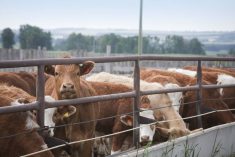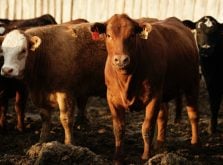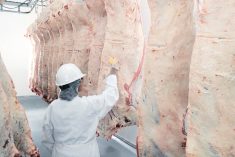During the first week of February, Alberta packers were buying fed cattle on a dressed basis in the range of $260-$270 delivered. Live prices were quoted from $160-$162 FOB the feedlot.
Western Canada is contending with a backlog of market-ready supplies due to the sharp year-over-year increase in feedlot placements in the latter half of 2021. The situation is reversed in the U.S. Early in February, fed cattle in Kansas and Texas were trading on a live basis at US$140 FOB the feedlot. The Canadian equivalent would be $180.
Read Also

Harvest wraps up and fall work begins
At the Eppich famly ranch in western Saskatchewan, the fall harvest was successful with few breakdowns, cows and calves have been sorted and a new tractor has arrived
The U.S. fed cattle market is trading at an $18 premium to Alberta because the U.S. had a sharp year-over-year decrease in feedlot placements during the fall of 2021. This situation has resulted in a diverse price range for feeder cattle in Western Canada. For example, in northwest Manitoba, mixed steers weighing 740 pounds were valued at $208, whereas in central Alberta, larger-frame Simmental blended steers averaging 710 pounds sold for $192.
The price spreads in feeder cattle have been further enhanced by the proximity to feed grains. We’ve seen stronger demand from Ontario and U.S. buyers for feeder cattle in Manitoba and Eastern Saskatchewan. Ontario had a record corn crop while Nebraska corn yields were also above average last year.
The USDA reported total cattle on feed inventories in 1,000-head-plus feedlots as of Jan. 1, 2022 at 12.037 million head, up one per cent from Jan. 1 of 2021. If you look at the placements by weight category, there was a sharp year-over-year increase in cattle placed under 800 pounds.
U.S. feedlot placements during December in the 900-pound-plus category were actually down from a year ago. More importantly, U.S. feedlot placements from July through October 2021 were down 118,000 head from the same period of 2020. Therefore, market-ready supplies during the first quarter of 2022 will be down sharply from the first quarter of 2021. Lower placements during the late summer and early fall period have resulted in a year-over-year decrease in market-ready fed cattle supplies during the first quarter of 2022.
Market-ready supplies up in Canada
In Western Canada, we have the opposite environment regarding fed cattle market-ready supplies. Cattle on feed inventory in Alberta and Saskatchewan as of Jan. 1, 2022 was up 12 per cent from Jan. 1 of 2021. More importantly, feedlot placements in Alberta and Saskatchewan from July through October 2021 were up a whopping 189,500 head compared to the same timeframe of 2020. Therefore, fed cattle market-ready supplies during the first two months of 2022 are up about 150,000 head from the first two months of 2021. Feedlot operators in Alberta have been asking why the Alberta fed market is at such a discount to the U.S. Well, that’s because there is a huge backlog of market-ready supplies in Western Canada and there is no set-aside program this winter. Approximately 95 per cent of the calls and emails I receive are from cattle producers that don’t know how to analyze a cattle-on-feed report.
The backlog of fed cattle supplies will be cleaned up by late spring, when we’ll see Canadian fed cattle prices trade at a premium to U.S. values. The Alberta fed market will transition from encouraging demand through lower prices to rationing demand through higher prices.
The U.S. cattle inventory report confirmed herd contraction. The 2021 calf crop came in at 35.1 million head, down approximately 400,000 head from the 2020 output of 35.5 million head. More importantly, the number of beef cows that had calved as of Jan. 1, 2022 was 39.5 million head, down 800,000 head from the Jan. 1, 2021 number of 40.3 million. Heifers for beef cow replacement totalled 5.6 million head, down from 5.8 million last year. A lower calf crop results in lower feedlot placements which will eventually result in a year-over-year decline in beef production.
Hang on to cows
The cull cow market is very soft. This isn’t the time to be selling cows. This is the time to be buying bred cows and cow-calf pairs. The cow-calf producer needs to have more tools in their pocket to weather adverse storms. I’ve received many calls from producers over the past year and they’ve told me they’ve had to liquidate part of their herd.
This is the time to get an extra loan because the market is projected to be very strong next fall. The market risk is in your favour, so this is an opportune time to take on additional risk. As of mid-February, the March 2022 feeder cattle futures were at $165 while the November 2022 feeder contract was hovering at $187. Markets usually over-extend to the upside when there are tighter supplies because traders incorporate a risk premium due to the uncertainty in the actual numbers.
Feeder cattle supplies are going to be down next fall; how much is to be determined. If the feeder cattle futures move closer to the $200 level, the market will be encouraging expansion. This could take an additional 400,000 to 500,000 heifers out of the feeder cattle pool. If we see aggressive heifer retention next fall, the feeder cattle futures could move up to the $220 area. This is the unknown risk in the feeder market.















